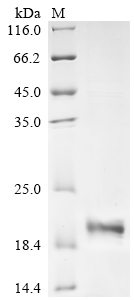Recombinant Human Urocortin-2 (UCN2) is produced in E. coli and includes amino acids 72 to 112 of the human sequence. This product represents a partial protein with an N-terminal 6xHis-SUMO tag that aids purification and detection. The protein reaches a purity level of over 90% based on SDS-PAGE analysis. Endotoxin levels remain low to ensure the product works well for research applications, though specific activity hasn't been determined.
Urocortin-2 belongs to the corticotropin-releasing factor (CRF) family, which appears to play a key role in how the body handles stress. Research suggests it may be important for cardiovascular function, particularly in regulating heart rate and blood pressure. Studies of Urocortin-2 are likely to advance our understanding of stress-related pathways and how the cardiovascular system is controlled.
Potential Applications
Note: The applications listed below are based on what we know about this protein's biological functions, published research, and experience from experts in the field. However, we haven't fully tested all of these applications ourselves yet. We'd recommend running some preliminary tests first to make sure they work for your specific research goals.
Based on the provided information, the folding state and bioactivity of this recombinant UCN2 protein fragment are unknown and must be considered highly uncertain. Urocortin-2 is a small, compact peptide hormone (the mature active form is only 38-40 amino acids) whose function is critically dependent on its correct disulfide bond formation and three-dimensional structure. Expressing only a portion of the precursor (72-112aa) in E. coli, a reducing cytoplasmic environment, makes proper disulfide bond formation unlikely. Furthermore, the presence of a very large N-terminal 6xHis-SUMO tag (SUMO is ~11 kDa, while the UCN2 fragment is ~4.5 kDa) will almost certainly prevent the peptide from adopting its native conformation and will sterically hinder its ability to bind its receptor, the CRF2 receptor. Therefore, it is highly improbable that this protein is correctly folded or bioactive.
1. Antibody Development and Validation
This recombinant UCN2 fragment is suitable for use as an immunogen to generate antibodies. The His-SUMO tag simplifies purification. However, it is critical to understand a major limitation: antibodies generated will be primarily against the linear epitopes of the UCN2 sequence fused to a large tag. The expressed region (72-112aa) includes the pro-sequence and part of the mature peptide, which is not the final circulating form. Therefore, the resulting antibodies are unlikely to recognize the native, correctly processed and folded Urocortin-2 peptide in biological samples. Its best use is for generating antibodies specific to this recombinant fusion protein.
2. Biochemical Characterization and Stability Studies
This purified recombinant fusion protein can be used for biochemical analysis of the fusion protein itself, such as studying its thermal stability and aggregation behavior. However, the biophysical properties measured (e.g., stability, pH tolerance) will be dominated by the large SUMO tag and will not reflect the properties of the native, mature Urocortin-2 peptide. This application is valid for characterizing the reagent, but the data cannot be extrapolated to understand the behavior of the natural hormone.
3. ELISA Development and Quantification Assays
The purified protein can serve as a standard or coating antigen for developing an ELISA. However, the utility of such an ELISA is extremely narrow. It can only be used to quantify or detect this specific recombinant His-SUMO-UCN2 fusion protein. It is not suitable for quantifying UCN2 levels in experimental samples because it will not recognize the native, processed UCN2 peptide found in biological fluids. It could only be used to validate antibodies made against the immunogen itself.
Final Recommendation & Action Plan
The recommended course of action is to use this protein reagent strictly for the purpose of generating anti-fusion protein antibodies (Application 1), with the clear understanding that these antibodies will have limited utility for studying native UCN2. The large SUMO tag will sterically block the receptor-binding site of the UCN2 peptide. Even if the UCN2 moiety were folded correctly, the tag would prevent meaningful interaction with the CRF2 receptor. Any interactions detected would be with the SUMO tag itself or non-specific, providing no insight into UCN2's true signaling pathways. Application 2 is only valid for characterizing the physical properties of the fusion protein reagent itself. For any functional studies (receptor binding, signaling) or for developing assays to detect biological UCN2, a different reagent is required.






